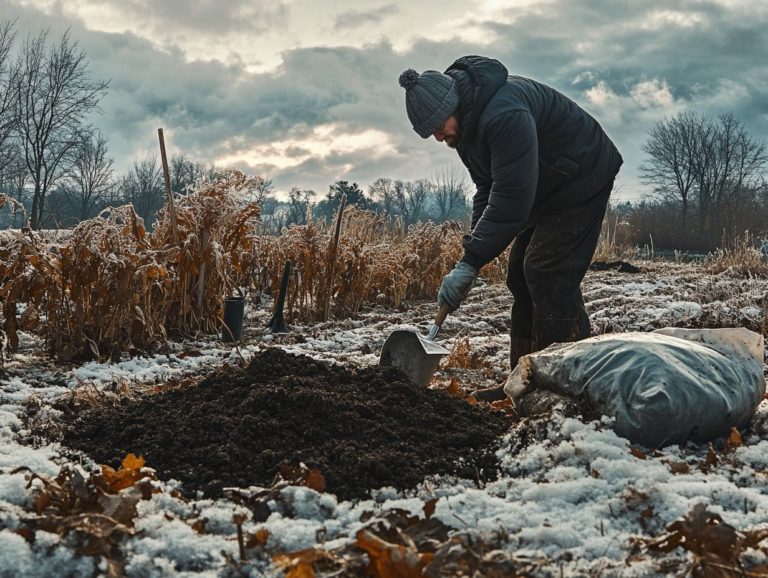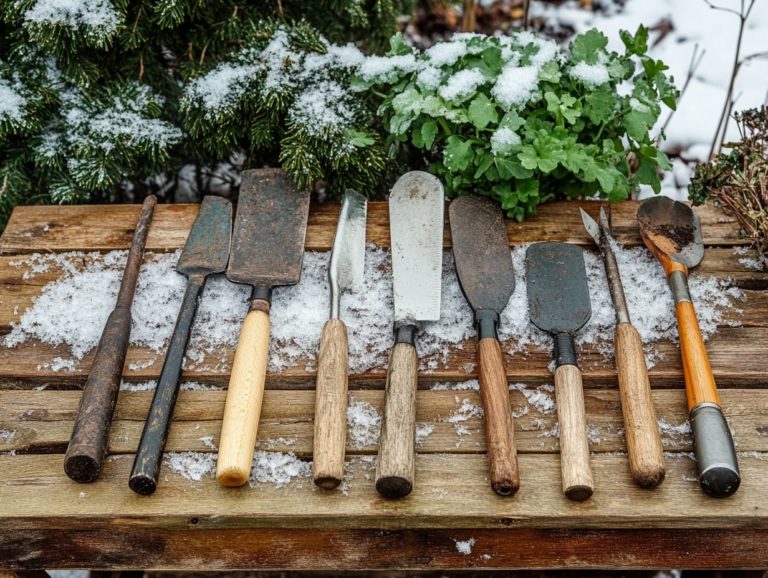How to Care for Your Tools in Low Temperatures
As winter settles in, you might notice that the chill in the air can have quite an impact on your tools! Whether it s hand tools or power equipment, those low temperatures can lead to various issues that could hinder their performance and reduce their lifespan.
Recognizing which tools are most susceptible to the cold and knowing the right maintenance techniques is crucial for any DIY enthusiast or professional.
This article will walk you through the common challenges cold weather presents, share practical woodworking tips for protecting tools and storing your tools, and offer solutions for tackling those frozen instruments.
Stay proactive against the cold to ensure your tools remain in peak condition throughout the winter season!
Contents
- Key Takeaways:
- The Importance of Proper Maintenance
- Common Tools Affected by Low Temperatures
- Tips for Protecting Your Tools
- Dealing with Frozen Tools
- Additional Considerations for Cold Weather Tool Care
- Impact of Salt and Other De-icing Methods
- Frequently Asked Questions
- How do I protect my tools from rust in low temperatures?
- What should I do if my tools freeze in cold temperatures?
- How can I prevent plastic parts of my tools from cracking in cold temperatures?
- Do I need to clean my tools before storing them for winter?
- Can I use my tools in cold temperatures without safety precautions?
- Should I lubricate my tools before using them in winter?
Key Takeaways:
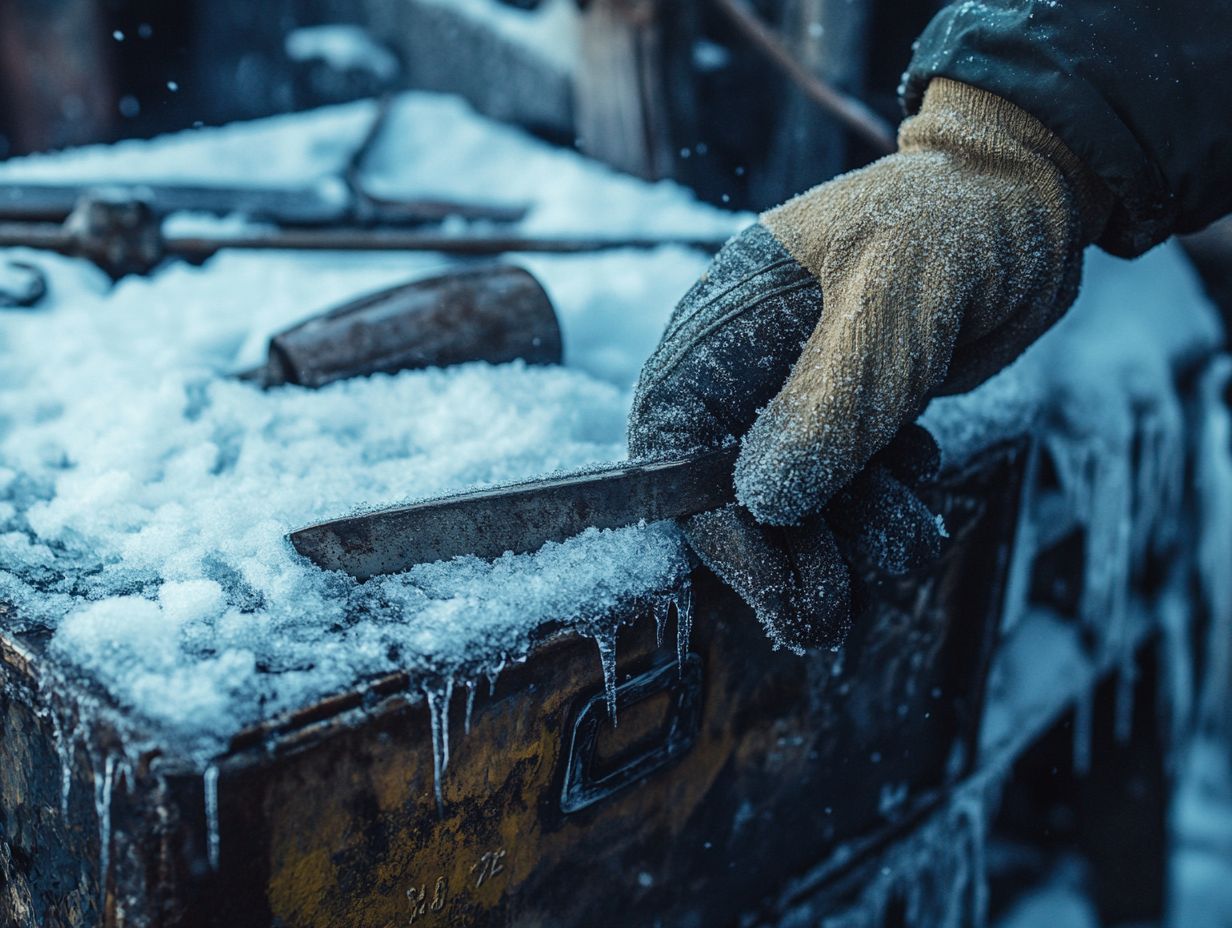
- Proper maintenance is crucial in low temperatures to ensure the longevity and functionality of your tools.
- Different types of tools have different vulnerabilities in cold weather, so it’s important to know how to protect them.
- Thawing and repairing frozen tools should be done carefully and quickly to prevent further damage.
The Importance of Proper Maintenance
Maintaining your woodworking tools is crucial, particularly during the winter months when temperatures can plummet to freezing levels, including the impact on your workspace stability.
Whether you’re using routers, saws, or other equipment, recognizing the significance of regular upkeep can save you from costly repairs and extend the lifespan of your tools.
When maintenance is overlooked, you might find your tools becoming brittle and their performance declining. This can make it difficult for you to achieve the high-quality work you strive for in your projects.
Common Tools Affected by Low Temperatures
You may not realize just how much low temperatures can impact your woodworking tools. They can cause problems like water buildup, tool brittleness, and an overall decline in performance, especially during outdoor work.
Tools such as a router table, saws, and power tools require your special attention during the winter months. Cold exposure often leads to malfunctions that can disrupt your outdoor projects.
Recognizing these vulnerabilities is essential for any craftsman who wants to keep their equipment in top shape and ensure safe, effective use.
Types of Tools and Their Vulnerabilities
Woodworking tools behave differently in cold weather. Some may break more easily, while others may not work at all. For instance, power tools might encounter breakdowns, while hand tools could become increasingly brittle, raising the risk of damage during use.
Hand tools, such as chisels, hand saws, and planes, tend to be more susceptible to breaking or chipping as they lose flexibility in frigid temperatures. If you don t store these tools properly, particularly in damp environments, you could also invite rust and corrosion.
On the flip side, power tools like drills, saws, and sanders face their own set of challenges, including battery failures or overheating. Keeping batteries warm and regularly maintaining your equipment can help you mitigate these risks.
Choose the right tool for each task. Store them in insulated places to make them last longer, allowing you to work efficiently even amidst the harsh winter weather.
Tips for Protecting Your Tools
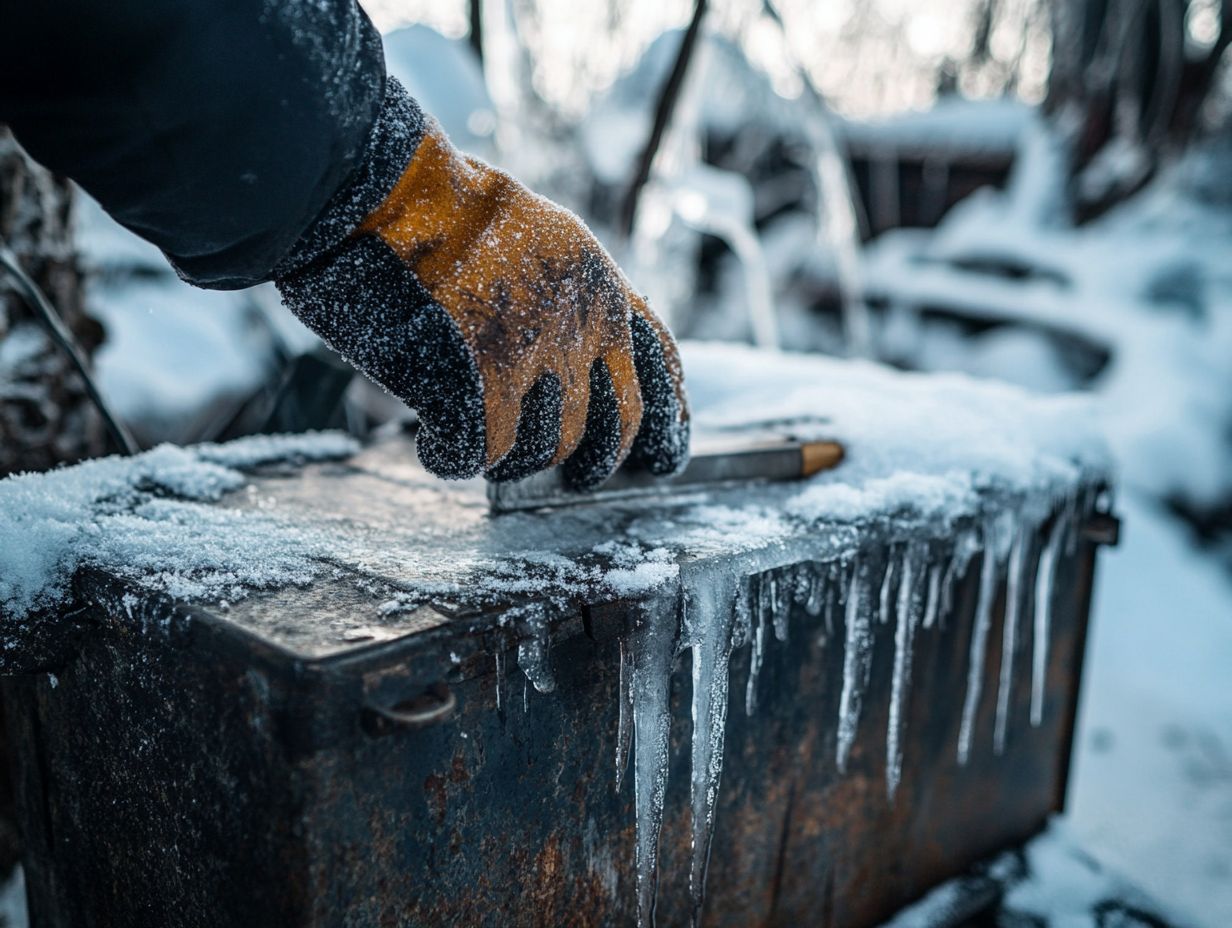
Protecting your tools from the harsh effects of cold weather is essential for preserving their longevity and effectiveness, especially for woodworking projects. To learn more about how to keep your garden tools from freezing, consider implementing some effective strategies.
Implementing effective storage solutions, like insulated coverings and air-tight insulation, will safeguard against water buildup and damage caused by freezing temperatures.
By embracing proper tool care techniques such as regular maintenance and thoughtful organization you ensure your workspace remains stable and productive, even during the winter months.
Start protecting your tools today to keep them performing their best!
Preventative Measures and Storage Techniques
Protect your woodworking tools from the cold! Implementing preventative measures and effective storage techniques is essential to safeguarding your tools against harmful effects of cold weather. By using insulated coverings and airtight containers, you can significantly reduce the risk of tool damage caused by freezing temperatures and moisture buildup.
Keeping tools safe and organized allows you to ensure that your equipment remains in prime condition throughout the winter months. Start by wrapping your tools in insulated materials to shield them from low temperatures and prevent condensation. Incorporating airtight containers for smaller items eliminates moisture intrusion, which is crucial in humid areas.
Organizing your workspace not only streamlines operations but also helps you keep track of which tools need protection. Placing your tools away from exterior walls or windows reduces exposure to cold drafts.
Additionally, considering the use of heated storage can offer added defense, ensuring your equipment stays at a safe temperature. By combining these strategies, you actively protect your invaluable tools year-round.
Dealing with Frozen Tools
When faced with frozen tools during the harsh winter months, act quickly to protect your tools from damage. Thawing your frozen tools properly and addressing repairs in a timely manner restores their functionality and prolongs their lifespan.
Taking the right approach during this process is vital; it safeguards the integrity and performance of your tools, especially those used in woodworking.
Thawing and Repairing Frozen Tools
Thawing and repairing frozen tools demands your careful attention to detail to avoid potential damage. Start by gradually warming the tools at room temperature; sudden temperature shifts can cause brittle tools to crack.
Once thawed, assess each tool for any signs of damage. Make the necessary repairs to keep them performing at their best in your woodworking projects. This process involves a meticulous inspection for rust, fractures, or other structural issues. If you spot damage, address it immediately with appropriate techniques, like oiling rusty parts or tightening loose screws.
Maintaining a clean workspace is crucial, as dust and debris can undermine a tool’s effectiveness. After completing your repairs, give each tool a thorough inspection to ensure they function correctly. By practicing these careful maintenance strategies, you not only extend the lifespan of your tools but also enhance safety during their use, paving the way for every project to proceed smoothly and efficiently.
Additional Considerations for Cold Weather Tool Care
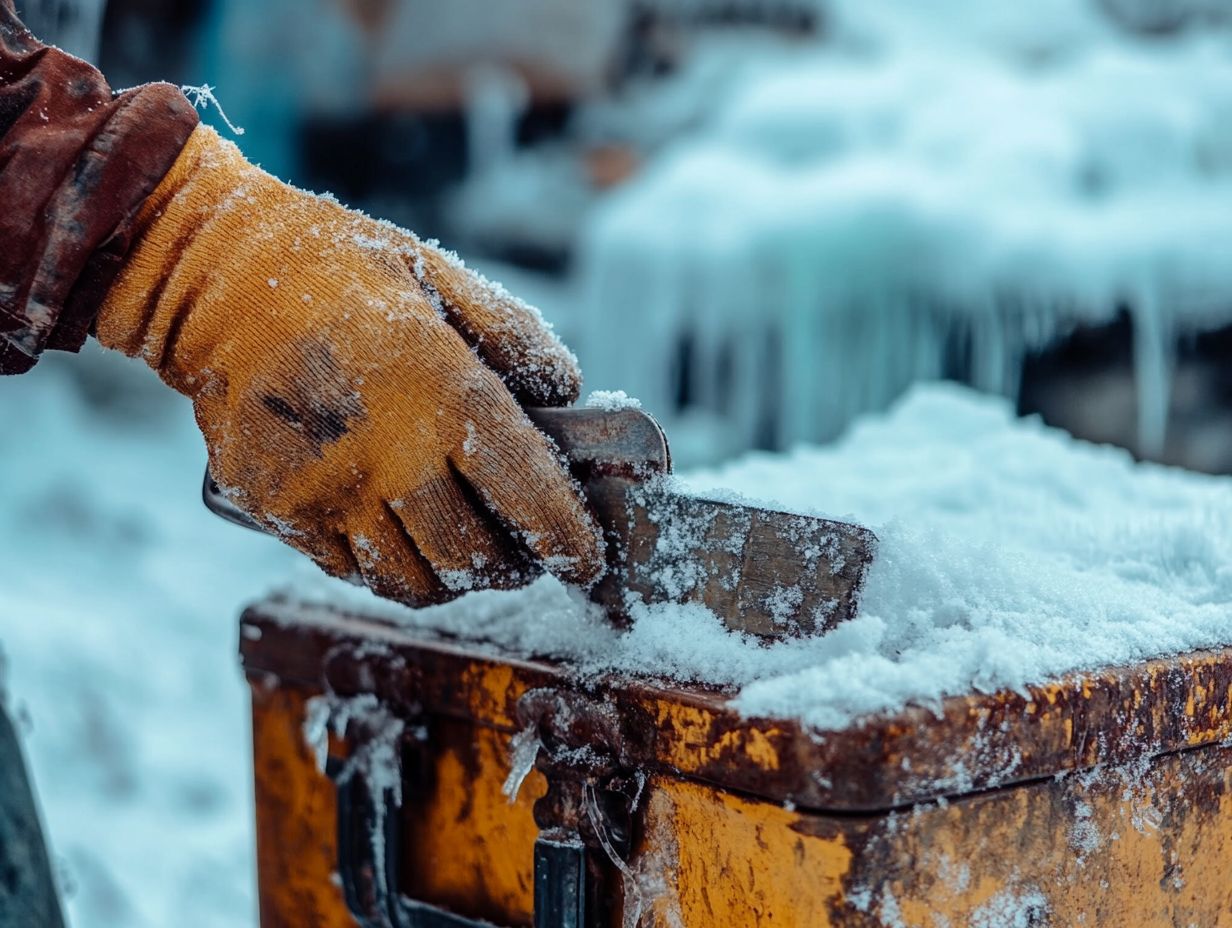
Along with fundamental strategies for shielding your tools from cold weather, consider finer points that can elevate your tool care and maintenance. Controlling moisture is paramount in preventing rust and deterioration, especially in storage areas.
Moreover, a safe and organized workshop can significantly reduce the risks associated with cold exposure. By embracing a holistic approach to tool care during winter, you can effectively safeguard your valuable equipment and ensure it remains in optimal condition.
Don t wait until it s too late! Follow these tips to keep your tools in top shape and ready for every project.
Impact of Salt and Other De-icing Methods
The use of salt and other de-icing methods during winter can significantly impact your woodworking tools. These methods can lead to rust and deterioration over time. Salt, commonly used for outdoor work and vehicle storage, can cause moisture buildup, compromising the integrity and functionality of your tools.
Particles from de-icers can cling stubbornly to surfaces. This creates an environment where even minor scratches may result in severe corrosion. Such deterioration not only shortens the lifespan of your tools but also affects the quality of your craftsmanship.
To counteract these issues, implement protective measures such as:
- Store your tools in a dry, climate-controlled environment
- Apply rust-resistant coatings
- Clean your equipment regularly after exposure to de-icing agents
By adopting these strategies, including tool organization, you can ensure that your woodworking tools remain in optimal condition. This enhances both their performance and longevity.
Frequently Asked Questions
How do I protect my tools from rust in low temperatures?
To protect your tools from rust in low temperatures, ensure they are completely dry before storing them. A quick application of oil or a rust prevention substance on the metal parts can work wonders. Keep them in a dry and temperature-controlled environment to prevent moisture buildup.
What should I do if my tools freeze in cold temperatures?
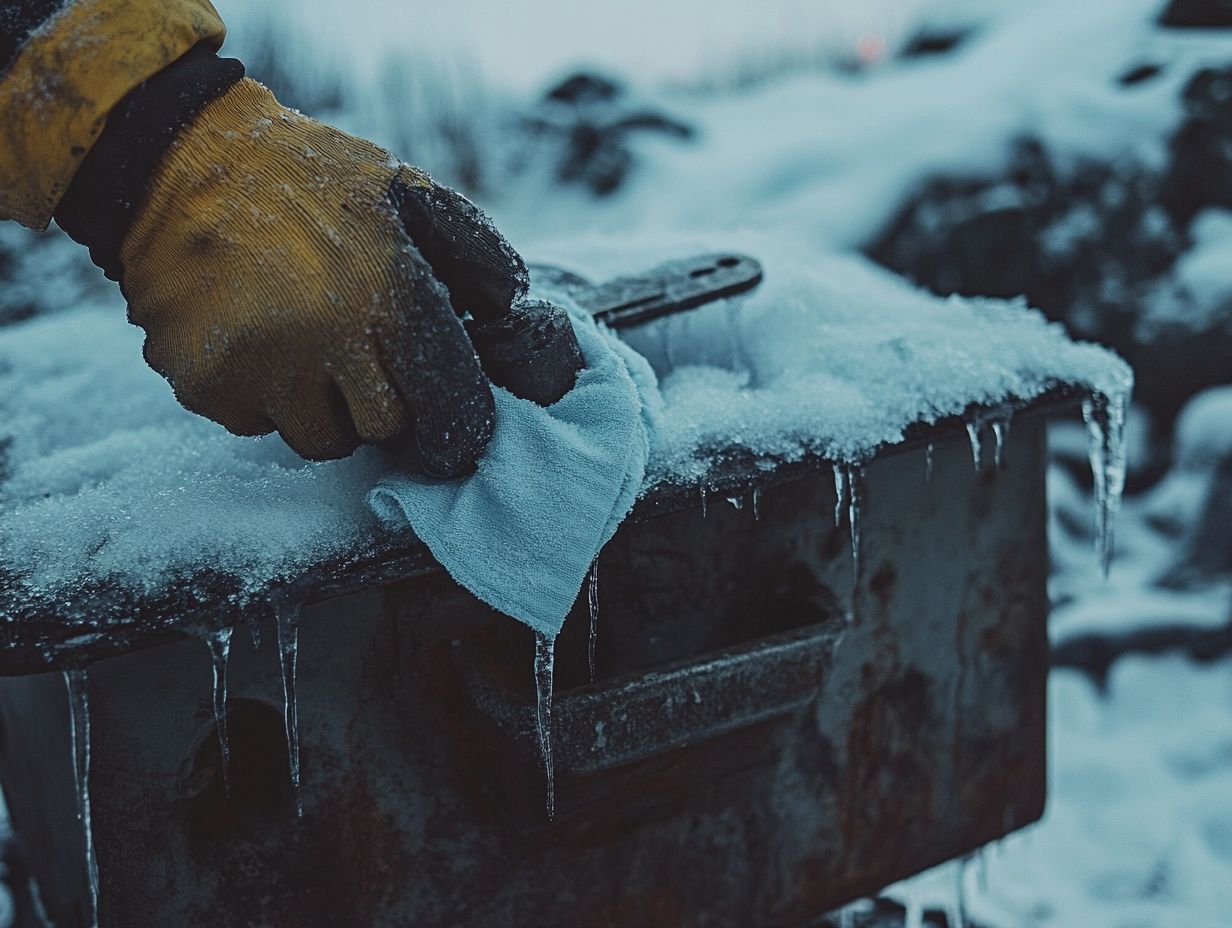
If your tools freeze, avoid forcing or rapidly thawing them. Allow them to thaw naturally in a temperature-controlled environment. Once thawed, dry them off and inspect for any damage before use.
How can I prevent plastic parts of my tools from cracking in cold temperatures?
To prevent plastic parts from cracking, avoid exposing them to extreme temperature changes. If possible, store your tools in a temperature-controlled environment. Warm them up gradually before use if you need to operate them in low temperatures.
Do I need to clean my tools before storing them for winter?
Don t wait! Clean your tools now to prevent rust. Dirt and debris can trap moisture and cause rust or damage. Use mild soap and water, and ensure they are completely dry before storage.
Can I use my tools in cold temperatures without safety precautions?
No, it is not advisable to use your tools in low temperatures without precautions. Cold can make metal brittle and increase the likelihood of plastic cracking. For tips on keeping your equipment in top shape, refer to how to maintain your gardening tools in winter. Taking preventive measures is essential for protecting your tools and ensuring their longevity.
Should I lubricate my tools before using them in winter?
Yes, lubricating your tools before winter use is a good idea. Lubrication protects metal parts from rust and helps prevent plastic parts from cracking. Use a lubricant specifically designed for low temperatures to avoid potential damage.




